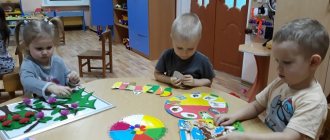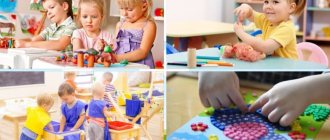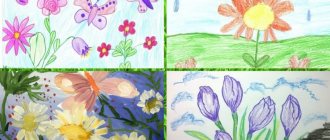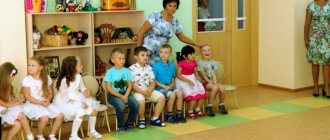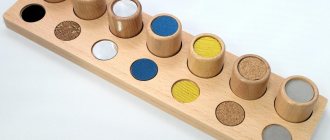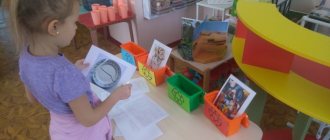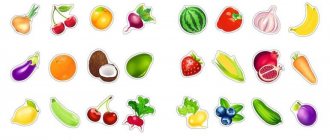Didactic game "Caterpillar"
Goal: to develop motor skills of the fingers through actions with objects, sensory perception, logical thinking
Game option: “Continue the row.”
Didactic manual “Finger dry pool”
Dry pool - used for simultaneous active stimulation on various points of the hands, fingers, palms; sensorimotor development, the formation of basic sensory standards: shape, size, material, weight, sound; fostering perseverance and patience in work; relieving emotional stress. It’s very simple to make: fill the Kinder Surprise capsules with various fillings (rice, peas, beans), cover them with thermal film for Easter eggs, put them in a small deep plastic container, and hide the Kinder Surprise toys at the bottom.
Ask your baby to look for various small objects or toys in the dry pool. By plunging as deeply as possible into the filler, the child’s hands are massaged, the fingers become more sensitive, and their movements become coordinated.
This manual can be used in music classes.
Didactic game “Beads from salt dough”
Goals:
- strengthening and development of fine motor skills, hand-eye coordination;
- developing the ability to combine colors;
- development of concentration; development of perseverance, accuracy, children's creativity, a sense of beauty in one's own work and the work of other children;
- learning how to work from a sample and create your own product.
This benefit can be done by the child himself, with a little help from an adult. Dough modeling really helps develop a child's motor skills. After all, a baby can change the shape of an object from a spherical shape to a square or triangular one. And, taking a piece of dough in his hands, he can feel its weight, heaviness and viscosity.
Description of the preparation of the manual:
Prepare salt dough (mix 1 cup of “Extra” salt, 1 cup of flour, 0.5 cups of cold water, leave for 2-3 hours in the refrigerator), form balls, make holes in them using a cocktail straw, leave until completely dry. The beads are ready!
Didactic manual “Place the eggs in your houses”
Goals:
- develop the ability to distinguish and correctly name the 4 primary colors;
- learn to combine a testicle with a cell, perform correlating actions (color guide); act purposefully, sequentially: from left to right, without skipping cells; develop fine motor skills of the fingers.
Description of the tutorial: Paint the cells of the egg container with the main colors and varnish them. We tie the Kinder Surprise capsules in the appropriate color.
The result is a bright and beautiful manual.
Children must arrange the eggs into houses according to their color.
If possible, name the color of the eggs and the color of the houses.
Didactic manual “Place the pencils in cups.”
Goals:
- develop the ability to distinguish colors;
- learn to combine a pencil with a glass; act purposefully, sequentially: from left to right; develop fine motor skills of the fingers.
Description of the tutorial: Cut out rectangles and pencil shapes from ceiling tiles. We cover the rectangles to the middle with squares of self-adhesive film of different colors. We paste the pencils with the corresponding colors. Fast, beautiful, economical!
"Tactile Box"
The tactile box is a teaching tool designed for young children.
Made from an ordinary shoe box, beautifully decorated with self-adhesive paper.
The box is filled with pieces of fabric of different textures: wool, fur, silk, guipure, etc. It also contains small objects: pebbles, soft toys, ribbons, zippers, laces, etc.
Children examine all the objects in the box with great interest with their hands.
The teaching aid “Tactile Box” helps children, using touch, to explore the world around them from a completely unusual point of view.
To ensure that kids don’t lose interest in the box -
From time to time you have to update the contents of the box and come up with different fillers.
The tactile box can be filled with objects that have completely opposite properties, for example: sandpaper, an iron key, pieces of foam rubber, a porcelain figurine, etc.
This manual can be used in direct educational activities, as well as in children’s independent activities (provided that it contains items that are safe for the life and health of children).
Didactic game “Find the extra traffic jam”
Means: corks of different colors and sizes.
Goal: development of logical thinking.
- Consciousness of an emotionally positive mood.
- Development of interest and motivation to action.
- Introducing sensory standards: getting to know different
- Properties of an object: size (large, small), shape (circle), color; developing the ability to alternate objects by color and size.
- Development of the motorized hand: developing the ability to perform actions with objects.
- Forming the skill of jointly completing a task: developing cultural communication skills;
- Development of the ability to understand and correctly perform tasks;
- Formation and activation of the child’s vocabulary: development of the ability to look at a picture, name the objects depicted on it, their qualities and actions;
- Development of perception: visual, tactile.
- Development of visual – effective, imaginative thinking, attention, memory, imagination.
Educational game for developing fine motor skills “Feed the piglet” with your own hands
Remedy: a soft toy (pig) and a bottle the size of the soft toy. Get mixed feed - beans, peas, corn flakes, etc.
Puzzles
You can create a geographic puzzle to explore the country. Buy or print an outline map, color each area with a different color (in addition, you can indicate clues - sea, mountains, attractions...), then glue the map onto a thick sheet of cardboard, cut it into squares or other shapes.
It is also very easy to create another puzzle. Collect 7-10 popsicle sticks and cut out a suitable picture from a magazine or draw it yourself. Place the sticks on a flat surface next to each other, stick the picture, wait until the glue dries and cut the sticks. Attach Velcro to the back of each stick so you can later attach the puzzle to the felt.
I recommend watching the video master class!
DIY | How to make a puzzle from a photograph | How to make a photo puzzle
Fantasies on the theme of checkers
Perhaps many people are tired of ordinary black and white checkers. In addition, they tend to get lost. It’s much more interesting if the checkers are made from something unusual! For example, these could be decorated sea pebbles, metal and plastic bottle caps, buttons, fabric pillows, etc. You have the opportunity to show your imagination and come up with something new!
Fleas
This is a very fun game played by 2 people. I press the edge of the bean with a coin and it jumps like a flea. The main task is to hit the enemy's goal with the flea, then you get a point and the flea is removed from the field. If a flea lands on your field, you can pick it up and use it next time; if a flea lands on your opponent’s field, the point is not counted and it simply remains lying there until the next turn. If the flea hits its own goal, the point is awarded to the opponent. The game continues until someone runs out of fleas.
To make a playing field, take a candy box, colored paper and thick fabric. Cover the inside of the box with colored paper and make fabric sides to prevent fleas from flying away. Use beans as fleas and don’t forget about large coins.
Alias
Another name for the game is “say otherwise.” The idea is simple: from 4 to 16 people play. Participants are divided into teams. A team can have 2,3,4 people. One of them pulls out a card on which 8-10 words are written, each word must be explained in other words, you can use sounds (for example: woof-woof, meow...) you cannot show and use words of the same root. You have 1 minute for 1 card, you need to quickly guess as many words as possible. You can make add-on cards on which emotions or instructions will be written. During the explanation, the person must be happy, or vice versa, sad, and the team must additionally guess the emotion and action that the explainer is doing. The team with the most guessed words wins. This game perfectly develops logical thinking and increases vocabulary.
Cut out cards from cardboard and beautifully write commonly used words, for example: soup, ice, monkey, enemy, sweet, photograph... There should be at least 30 cards with 10 words written on them. Words should not be repeated.
You can create a playing field for aliases. Mark the steps on it and make chips. The principle of creation is described in the game around the world. However, you can play without a field, just appoint a judge who will count the points and record the time.
Labyrinth
To create this game you will need a cardboard candy box, cocktail straws and a small ball, you can use a bead. Think over and draw a labyrinth. Glue the cocktail tubes. Place the ball and start the game.
I recommend watching the video master class!
Making a labyrinth with your own hands, a board game for children
Domino
For dominoes, create 28 pieces, they can be made by coloring pebbles, ice cream sticks, sewn from felt...
Chip scheme
Pebble dominoes
Felt dominoes
Popsicle stick dominoes
Monopoly
When creating this game with your own hands, you can use your city - it will be more interesting. Think about the colors of the districts, print out almost “real” money and come up with realistic tasks, for example: paying utility bills. Create your own exciting original game.
I recommend watching the video master class!
Do-it-yourself monopoly. Master Class
